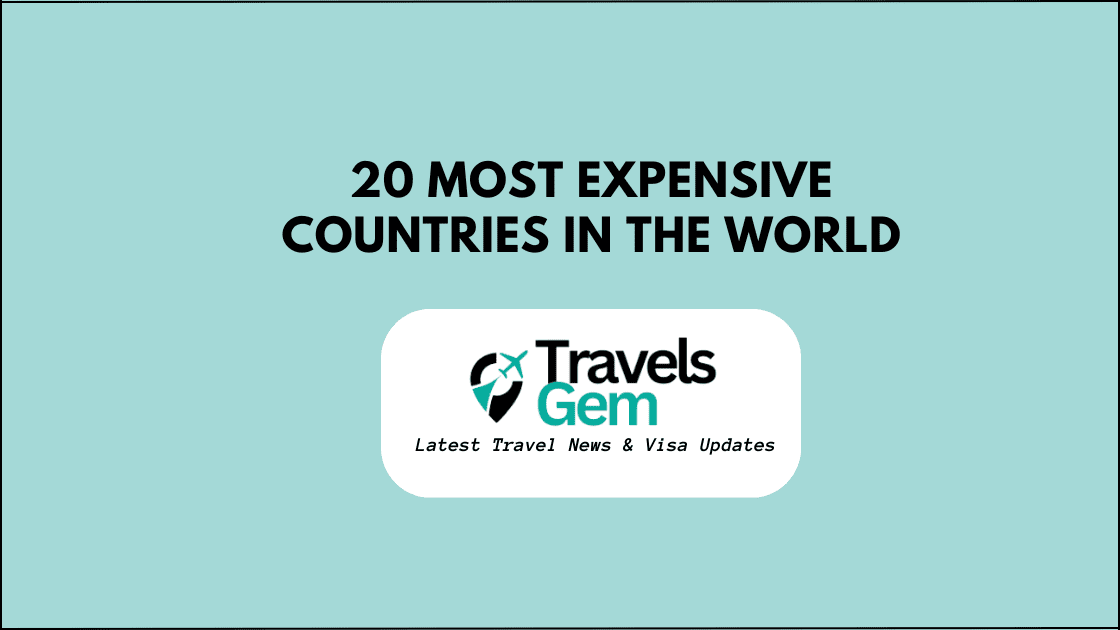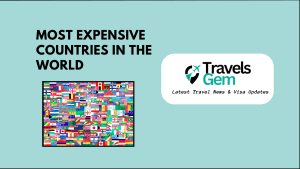Traveling is one of the best ways to refresh your mind and improve your well-being. Many wealthy individuals enjoy exploring different countries during their vacations, whether for leisure or business breaks. However, before setting off on an international trip, it is crucial to stay informed about the cost of living, inflation rates, and overall expenses in your chosen destination. This helps ensure a smooth journey without financial surprises.
In this article, we will highlight the 20 most expensive countries in the world in 2025, based on the cost of living, housing, food, transportation, and other essential expenses. Understanding these costs will help you plan your travels more efficiently and decide whether these luxurious destinations fit your budget.
Updated List of 20 Most Expensive Countries in the World in 2025
Bahamas
Switzerland
NorwayIceland
Denmark
Barbados
Singapore
Luxembourg
Hong Kong
Australia
Austria
Canada
New Zealand
Ireland
Sweden
The Netherlands
Finland
France
The United States of America
Japan
This above list highlights 20 most expensive countries in the world. Rankings are based on the cost of living index, factoring in housing, transport, and food prices. Data is sourced from Numbeo, Forbes, and The World Bank.
What Makes a Country Expensive?
Several factors contribute to a country being classified as expensive:
- High Cost of Living: The cost of recreation, food, accommodation, transportation, and medical care is much greater.
- Strong Currency: Countries with strong currencies make traveling and living costs expensive for foreign visitors.
- Luxury Lifestyle: A higher standard of living often results in costly goods and services.
- High Taxes & Import Duties: Countries that impose heavy taxes on goods and services generally have expensive lifestyles.
- Economic Stability: Nations with stable economies and high-income residents often have higher living costs.
What are Most Expensive Countries in the World in 2025
Following are the countries included in the most expensive countries in the world in 2025.
1. Bahamas
The Bahamas is a stunning island nation located in the Caribbean, covering a land area of 13,880 km² with a population of approximately 400,000 people. Known for its breathtaking beaches and crystal-clear waters, the country is home to famous destinations such as Nassau, Paradise Island, Exuma Cays, Andros Island, and Harbour Island. The cost of living is high, driven by significant import costs, and the inflation rate continues to rise, impacting daily expenses.

Employment in the Bahamas is mainly dependent on tourism and financial services, with seasonal job fluctuations affecting income stability. Both public and private educational institutions as well as universitiesThe standard of living is high, but expenses such as rent, healthcare, and groceries make it costly for residents. Healthcare services are available through public and private hospitals, with costs ranging from BSD 54 per month for basic plans to BSD 1,092 for high-limit plans. The political structure follows a parliamentary democracy, with governance influenced by the British legal system.
Cost of Living in the Bahamas
- Healthcare Expenses: Basic plan BSD 54 per month, high-limit plan BSD 1,092 per month
- Transportation Costs: BSD 45-55 per month
- Groceries: BSD 400 to BSD 600 per month
- Cost of Living Index: Approximately 84-90
- Average Rent: BSD 1,000-3,000 per month, luxury stays BSD 300 per night
Traveling Expense Guide
If you plan to visit the Bahamas, it’s essential to budget travel accordingly.
- Visa Costs:
- Without biometric data: BSD 110 for 3 months to 1 year, BSD 500 for 3 years
- With biometric data: BSD 250 for 3 months to 1 year, BSD 500 for 3 years (Visa fees are non-refundable)
- Traveling Costs:
- Flight and daily expenses: BSD 286 per day per person, including hotel, food, and transportation
- Organized tour package: BSD 330 per day
- Accommodation Costs:
- BSD 1,318 for a one-bedroom apartment in the heart of the city
- BSD 1,400 for a one-bedroom apartment outside of the city center
- BSD 3,585 for a three-bedroom apartment in the heart of the city
- BSD 3,400 for a three-bedroom apartment outside of the city center
The Bahamas is an expensive destination, but its luxurious lifestyle, beautiful landscapes, and vibrant tourism industry make it a top choice for travelers and expatriates.
2. Switzerland
Switzerland is a beautiful, landlocked country in Central Europe, covering a land area of 41,290 km² with a population of around 8.7 million people. In addition to towns like Zurich, Geneva, Lucerne, and Interlaken, it is renowned for its stunning scenery, which include the Matterhorn, Lake Geneva, and the Swiss Alps. Switzerland has a strong economy, with major industries in banking, pharmaceuticals, watchmaking, and tourism. The inflation rate remains low, ensuring economic stability.

Employment in Switzerland is competitive, with low unemployment rates and high salaries, but the cost of living is one of the highest in the world. The education system is excellent, offering public, private, and international schools, along with prestigious universities like ETH Zurich and the University of Geneva. The standard of living is extremely high, with excellent infrastructure, clean cities, and a strong social security system. Healthcare is required, and insurance rates range from 300 to 500 CHF per month. The country operates under a federal direct democracy, meaning citizens have a direct say in political decisions.
Cost of Living in Switzerland
- Healthcare Expenses: Mandatory insurance, CHF 300-500 per month
- Transportation Costs: CHF 70-100 per month
- Groceries: CHF 800-1,000 per month for a family
- Cost of Living Index: Approximately 100-105
- Average Rent: CHF 2,000-3,000 per month, varying by city
Traveling Expense Guide
If you plan to visit Switzerland, budget accordingly for high expenses.
- Visa Costs:
- Children up to 6 years: Free
- Children 6-12 years: CHF 45
- Adults: CHF 90
- Appeal cost: CHF 200
- Family members of EU/EFTA citizens: Free
- Traveling Costs:
- Daily expenses: CHF 183 per person, including transportation, accommodation, food, and activities
- Accommodation Costs:
- 1-bedroom apartment (city center): CHF 1,692
- 1-bedroom apartment (outside center): CHF 1,369
- 3-bedroom apartment (city center): CHF 3,036
- 3-bedroom apartment (outside center): CHF 2,478
Switzerland is an expensive yet high-quality destination, offering a safe and efficient lifestyle with world-class healthcare, education, and infrastructure.
3. Norway
The Scandinavian nation of Norway is well-known for its Viking past, breathtaking fjords, and northern lights. It covers a land area of 385,207 km² and has a population of around 5.4 million people. Some of its most famous places include Oslo, Bergen, Tromsø, the Lofoten Islands, and Geirangerfjord. Norway has a strong economy, mainly driven by oil, gas, fishing, and technology, and maintains a low unemployment rate. The inflation rate is relatively low, ensuring economic stability.
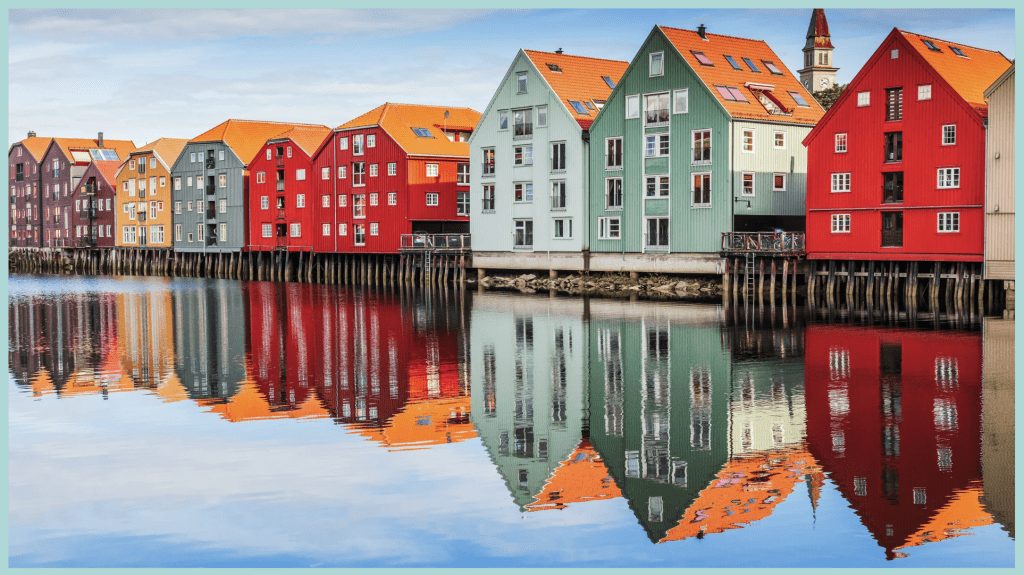
Norway has a well-organized educational system that includes free public schools and colleges. The standard of living is among the highest in the world, offering excellent infrastructure, social security, and work-life balance. Norway has a universal healthcare system, with public healthcare heavily subsidized, though private insurance costs around NOK 500–1,000 per month. In terms of politics, Norway is a parliamentary constitutional monarchy that guarantees a stable democracy.
Cost of Living in Norway
- Healthcare Costs: the price of private insurance is NOK 500–1,000 per month, whereas public healthcare is subsidized.
- Transportation Costs: NOK 700-1,000 per month
- Groceries: NOK 5,000-7,000 per month, higher than in many other countries
- Cost of Living Index: Approximately 74-79
- Average Rent: NOK 10,000-15,000 per month
Traveling Expense Guide
If you are planning to visit Norway, consider the high costs of living and travel.
- Visa Costs:
- Under 6 years old: Free
- Ages 6-12: €45
- Over 12 years old: €90
- Traveling Costs:
- Around $113 per day, including local transportation, meals, and accommodation
- Accommodation Costs:
- 1-bedroom apartment (city center): NOK 13,000
- 1-bedroom apartment (outside center): NOK 9,900
- 3-bedroom apartment (city center): NOK 20,200
- 3-bedroom apartment (outside center): NOK 15,580
Norway offers an exceptional quality of life, breathtaking natural beauty, and a strong welfare system, but it is also one of the most expensive countries in the world in 2025 to live and travel in.
4. Iceland
Iceland is a Nordic island country known for its breathtaking landscapes, volcanoes, geysers, and hot springs. It covers a land area of 103,000 km² and has a population of around 376,000 people, making it among the nations with the fewest populations in the world. Some of its most famous places include Reykjavik (the capital), the Blue Lagoon, Gullfoss Waterfall, the Northern Lights, and Vatnajökull National Park. Iceland has a low unemployment rate and a robust economy that is mostly powered by tourism, fishing, and renewable energy. The inflation rate fluctuates but remains moderate due to Iceland’s small economy and reliance on imports.

The education system is high-quality, with free primary, secondary, and university education. Excellent public services and a robust social security system make the level of life one of the highest in the world. Iceland has a universal healthcare system, where public healthcare is largely free, though private insurance costs ISK 15,000-20,000 per month. Politically, Iceland is a parliamentary republic, ensuring a stable and transparent government.
Cost of Living in Iceland
- Cost of healthcare: While public healthcare is free, costs of private insurance is ISK 15k to 20k per month.
- Transportation Costs: ISK 12,000-15,000 per month
- Groceries: ISK 60,000-80,000 per month, due to high import costs
- Cost of Living Index: Approximately 80-85
- Average Rent: ISK 180,000-250,000 per month
Traveling Expense Guide
If you ever intend to travel to Iceland, be ready for high living and transport costs.
- Visa Costs:
- Children under 6: Free
- Adults: €90
- Traveling Costs:
- About $225 a day, which covers lodging, meals, and transportation
- Accommodation Costs:
- 1-bedroom apartment (city center): ISK 280,600
- 1-bedroom apartment (outside center): ISK 249,260
- 3-bedroom apartment (city center): ISK 393,960
- 3-bedroom apartment (outside center): ISK 339,120
Iceland is a stunning travel destination with a high standard of living, but it is also one of the most expensive countries to live in due to its remote location and dependence on imports.
5. Denmark
Denmark, a Scandinavian country known for its rich history, modern design, and high quality of life, covers a land area of 42,933 km² and has a population of approximately 5.9 million people. The country is famous for its picturesque cities, breathtaking beaches and a thriving cultural landscape. Some of the most popular destinations include Copenhagen (the capital), Tivoli Gardens, Nyhavn, The Little Mermaid statue, Legoland Billund, and Kronborg Castle. Denmark has a robust economy powered by industries like renewable energy and an extremely low unemployment rate, pharmaceuticals, and technology. Its inflation rate remains stable, ensuring a high standard of living.

The education system is among the best in the world, offering free education from primary school to university for Danish and EU citizens. Denmark’s standard of living is high, with a significant emphasis on social welfare, sustainability, and balance between work and personal life. The healthcare system is primarily public and free for residents, but private insurance costs between DKK 500–1,000 per month.
Cost of Living in Denmark
- Healthcare cost: Free Public healthcare is provided and private insurance costs DKK 500–1,000 per month
- Transportation Costs: DKK 400-700 per month
- Groceries: DKK 3,000-5,000 per month
- Cost of Living Index: Approximately 70-75
- Average Rent: DKK 8,000-12,000 per month
Traveling Expense Guide
If you’re planning to visit Denmark, be prepared for moderate to high expenses.
- Visa Costs:
- Short-stay visa fee: €90
- Children (ages 6 to 11 years): €45
- Nationals covered by the visa-facilitation agreement: €35
- Long-stay visa (D visa): €195
- Traveling Costs:
- kr1,585 per person daily, covering accommodation, food, and transport
- Accommodation Costs:
- 1-bedroom apartment (city center): DKK 7,730
- 1-bedroom apartment (outside center): DKK 6,080
- 3-bedroom apartment (city center): DKK 13,860
- 3-bedroom apartment (outside center): DKK 10,930
Denmark offers a safe, clean, and well-organized environment, making it an excellent place to live and visit, though living costs are relatively high compared to many other European countries.
6. Barbados
The Caribbean island nation of Barbados Is renowned for its vibrant culture and stunning beaches, and extensive colonial past. With a total area of 430 km2, the island is home to over 280,000 inhabitants. Some of its most famous attractions include Harrison’s Cave, Bathsheba Beach, St. Nicholas Abbey, Bridgetown (the capital), and the historic Garrison district. The country enjoys a stable economy, with tourism, finance, and agriculture (especially sugarcane) being the key industries. Nonetheless, Barbados’ cost of living has been impacted by recent mild inflation.

The education system is well-developed, with free primary and secondary education and a strong emphasis on literacy and higher learning. The standard of living is high, supported by modern infrastructure, a strong service sector, and a safe environment. Private healthcare costs start from BSD 300, and public and private medical facilities are available via the healthcare system.
Cost of Living in Barbados
- Healthcare Expenses: Start from BSD 300 per month
- Transportation Costs: BSD 200-250 per month
- Groceries: BSD 900-1,000 per month
- Cost of Living Index: Approximately 75-80
- Average Rent: BSD 2,000-4,000 per month
Traveling Expense Guide
If you’re planning to visit Barbados, prepare for moderate to high travel expenses.
- Visa Costs:
- Short-term visa: USD 148
- Longer-term visa (2-10 years): USD 557-1,241
- Visiting academic visa: USD 258
- Marriage visa: USD 148
- Traveling Costs:
- Average daily expense: BSD 883 per person, covering accommodation, food, and transportation
- Accommodation Costs:
- 1-bedroom apartment (city center): BSD 1,330
- 1-bedroom apartment (outside center): BSD 1,090
- 3-bedroom apartment (city center): BSD 3,520
- 3-bedroom apartment (outside center): BSD 12,420
Barbados offers a relaxed island lifestyle, high safety standards, and a thriving expat community, making it a desirable place to live and visit, though costs can be relatively high compared to other Caribbean destinations.
7. Singapore
Southeast Asia’s Singapore is a small but highly sophisticated city-state renowned for its skyscrapers, effective infrastructure, and rich cultural legacy. Covering an area of 733 km², it has a population of approximately 5.6 million people. Despite its small size, Singapore is home to some of the most well-known tourist destinations in the world, such as the Singapore Zoo, Marina Bay Sands, Gardens by the Bay, Sentosa Island, and Universal Studios Singapore. The country has a strong economy, driven by finance, trade, technology, and manufacturing, but inflation has been moderate to high in recent years.

The employment rate in Singapore is high, with a low unemployment rate due to the country’s pro-business environment and demand for skilled workers. The education system is among the best in the world, offering high-quality public and private schooling, with a strong focus on STEM (Science, Technology, Engineering, and Mathematics). The standard of living is very high, supported by world-class public transport, safety, and modern infrastructure. Singapore’s healthcare system benefits from government subsidies, while private health insurance typically ranges from SGD 100 to 200 per month. The nation functions as a parliamentary republic, with a prime minister in charge of the cabinet and a president acting as head of state.
Cost of Living in Singapore
- Healthcare Expenses: SGD 100-200 per month for private insurance
- Transportation Costs: SGD 90-120 per month
- Groceries: SGD 500-800 per month
- Cost of Living Index: Approximately 75-80
- Average Rent: SGD 2,000-4,000 per month
Traveling Expense Guide
If you’re planning to visit Singapore, be prepared for a moderate to high cost of travel.
- Visa Costs:
- Standard Visa: SGD 30 (non-refundable fee)
- Traveling Costs:
- Average daily expense: SGD 234 per person, covering accommodation, food, and transport
- Accommodation Costs:
- 1-bedroom apartment (city center): SGD 3,910
- 1-bedroom apartment (outside center): SGD 2,800
- 3-bedroom apartment (city center): SGD 7,830
- 3-bedroom apartment (outside center): SGD 4,945
Singapore is a significant global financial hub known for its effective governmental services and pristine environment, and stringent rules. While the cost of living is high, it offers top-tier education, healthcare, and career opportunities, making it one of the most desirable places to live and work in Asia.
8. Luxembourg
One of the richest and smallest nations in the world, Luxembourg is situated in Western Europe and has borders with Germany, France, and Belgium. With a total land area of 2,586 km², it has a population of approximately 660,000 people. The country is famous for its stunning scenery, thriving financial industry, and historic castles. The Grand Ducal Palace, the Casemates du Bock, the Old Quarter of Luxembourg City (a UNESCO World Heritage Site), and Vianden Castle are some of the city’s most notable attractions. The inflation rate in Luxembourg fluctuates but has remained relatively stable compared to other European nations.
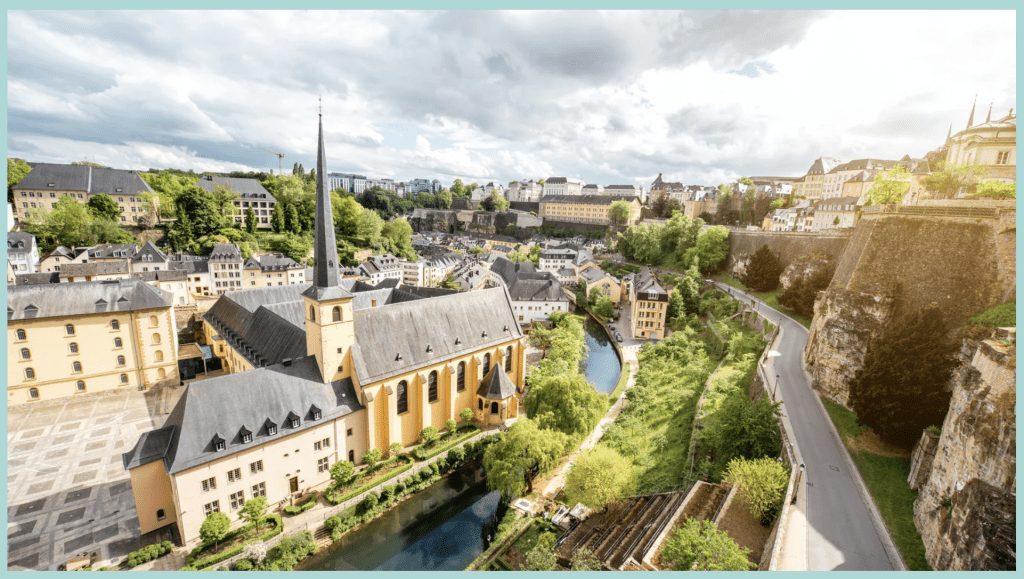
The banking, technology, and logistics industries are booming in Luxembourg, which boasts one of the highest employment rates in Europe. The education system is multilingual, offering courses in Luxembourgish, French, and German, making it one of the most diverse in the world. The standard of living is exceptionally high, thanks to a strong economy, low unemployment, and excellent public services. The healthcare system is publicly funded, ensuring comprehensive coverage, though private insurance may cost between EUR 150-300 per month.
Cost of Living in Luxembourg
- Healthcare Expenses: EUR 150-300 per month for private insurance
- Transportation Costs: EUR 40-80 per month
- Groceries: EUR 400-600 per month
- Cost of Living Index: Approximately 60-65
- Average Rent: EUR 1,500-2,500 per month
Traveling Expense Guide
If you’re planning to visit Luxembourg, prepare for a moderate to high cost of travel.
- Visa Costs:
- Schengen Visa Fee: EUR 80
- Children (6-12 years): EUR 40
- Children under 6 years: Free
- Traveling Costs:
- Average daily expense: EUR 236 per person, covering accommodation, food, and transport
- Accommodation Costs:
- 1-bedroom apartment (city center): EUR 3,910
- 1-bedroom apartment (outside center): EUR 1,545
- 3-bedroom apartment (city center): EUR 3,230
- 3-bedroom apartment (outside center): EUR 2,550
A major international financial center, Luxembourg is renowned for its robust social security system, multilingual workforce, and high earnings. While the cost of living is high, residents enjoy top-tier education, excellent healthcare, and a strong economy, making it one of the best countries for both work and leisure in Europe.
9. Hong Kong
Hong Kong, a vibrant metropolis in East Asia, is known for its skyline, bustling markets, and cultural diversity.There are over 7.5 million people living there and comprises 1,104 km² of land. In spite of its tiny size, One of the cities with the densest populations in the world is Hong Kong. Some of its most famous attractions include Victoria Peak, Disneyland Hong Kong, the Avenue of Stars, Lantau Island, and the bustling shopping districts of MongKok and Causeway Bay. The inflation rate in Hong Kong varies but typically remains between 1-3%, influenced by housing costs and global economic trends.

The job market in Hong Kong is robust, particularly in the tourist, trade, banking, and logistics sectors. With English and Cantonese instruction in schools and top-tier universities like the University of Hong Kong (HKU), the educational system is based on a British curriculum. Although there is a high level of life, living expenses are significant, especially when it comes to housing.
The healthcare system in Hong Kong is among the best in Asia, with public healthcare heavily subsidized, though private health insurance can range from HKD 1,000-2,000 per month. The political system is based on the “one country, two systems” concept and is a partical Administrative China’s SAR region. Though China’s influence has grown recently, it still has its own political, economic, and judicial structure.
Cost of Living in Hong Kong
- Healthcare Expenses: HKD 1,000-2,000 per month for private insurance
- Transportation Costs: HKD 500-800 per month
- Groceries: HKD 3,000-5,000 per month
- Cost of Living Index: Approximately 69-74
- Average Rent: HKD 15,000-30,000 per month
Traveling Expense Guide
Although Hong Kong is a well-liked vacation spot, prices can differ based on your spending limit.
- Visa Costs:
- Ordinary visa fee: HKD 230
- Transit visa fee: HKD 120
- Traveling Costs:
- Budget travelers: HKD 610 per day
- Luxury travelers: HKD 3,770 per day
- Accommodation Costs:
- 1-bedroom apartment (city center): HKD 16,270
- 1-bedroom apartment (outside center): HKD 12,340
- 3-bedroom apartment (city center): HKD 35,175
- 3-bedroom apartment (outside center): HKD 24,700
Hong Kong is a dynamic global city, known for its fast-paced lifestyle, economic opportunities, and cultural diversity. While it has high living costs, it also offers world-class healthcare, education, and business opportunities, making it a top destination for both residents and travelers.
10. Australia
Australia is the sixth-largest country in the world, known for its modern cities, unique wildlife, and beautiful landscapes. Despite its vast size of 7.68 million km², it has a relatively small population and is home to about 26 million people. The Sydney Opera House, the Great Barrier Reef, Uluru, the Twelve Apostles, Bondi Beach, and the Daintree Rainforest are a few of its most well-known locations. Australia’s inflation rate normally ranges from 3 to 6%, depending on both domestic and international economic factors.
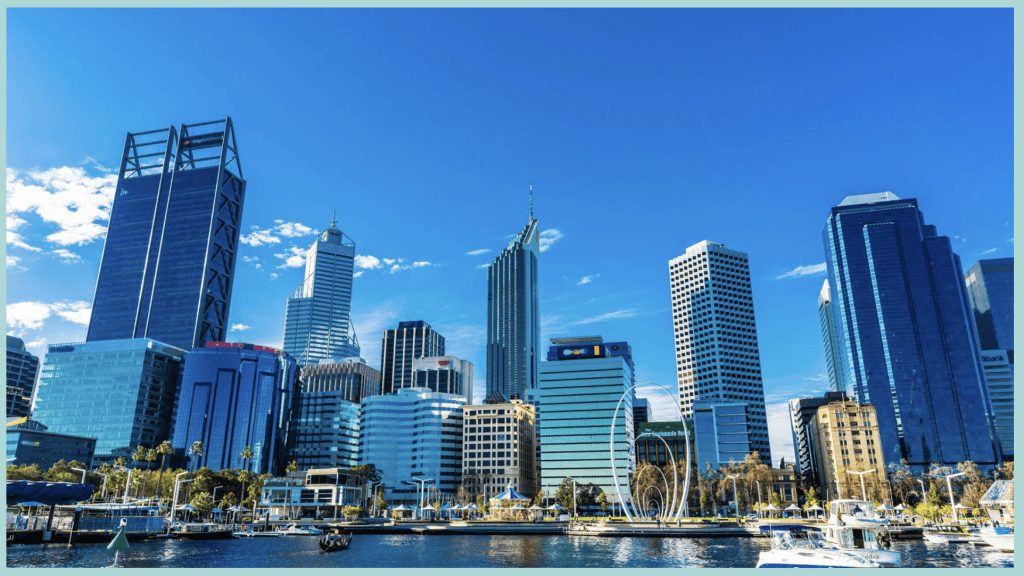
The country has a strong job market, particularly in healthcare, mining, finance, and technology, and offers high wages and stable employment opportunities. With internationally recognized universities like the University of Melbourne, Australian National University (ANU), and the University of Sydney, the educational system is among the greatest in the world. Public education is free or low-cost for citizens, while private education and international tuition fees can be expensive.
Australia is renowned for its robust economy, laid-back culture, first-rate infrastructure, and high level of living. The healthcare system is one of the best globally, with public healthcare (Medicare) subsidizing medical expenses while private health insurance costs between AUD 100-300 per month.
The political structure is a federal parliamentary democracy, with a constitutional monarchy under King Charles III, represented by a Governor-General. Australia maintains strong economic ties with major global markets, making it an attractive destination for expats and businesses.
Cost of Living in Australia
- Healthcare Expenses: AUD 100-300 per month for private insurance
- Transportation Costs: AUD 120-200 per month
- Groceries: AUD 600-800 per month
- Cost of Living Index: Approximately 68-72
- Average Rent: AUD 2,000-3,500 per month
Traveling Expense Guide
If you intend to travel to Australia, be ready for comparatively hefty travel expenses.
- Visa Costs:
- Visitor visa application: AUD 105
- Traveling Costs:
- Two-week average travel cost: AUD 3,970
- Accommodation Costs:
- 1-bedroom apartment (city center): AUD 2,130
- 1-bedroom apartment (outside center): AUD 1,685
- 3-bedroom apartment (city center): AUD 3,520
- 3-bedroom apartment (outside center): AUD 2,610
Australia is an incredible place to live and visit, offering beautiful landscapes, a high quality of life, and strong economic opportunities. Even while living expenses can be costly, the nation is a preferred destination for tourists, students, and expats due to its first-rate healthcare, education, and job opportunities.
11. Austria
Central Europe’s Austria is renowned for its breathtaking scenery, extensive history, and thriving cultural scene. There are over 9 million people living there and has a total area of 83,879 km². Some of Austria’s most famous places include Vienna’s Schönbrunn Palace, Salzburg (the birthplace of Mozart), the picturesque Hallstatt village, the Alps for skiing, and the historic town of Innsbruck. The country’s inflation rate generally fluctuates between 4-6%, impacting consumer prices and daily expenses.

Austria boasts a strong and stable job market, particularly in engineering, IT, tourism, and finance. Austria is renowned for providing competitive wages and first-class working conditions, and the unemployment rate is still comparatively low. The education system is one of the best in Europe, offering free primary and secondary education, along with affordable higher education options at prestigious institutions like the University of Vienna and TU Wien.
Austria boasts an outstanding standard of living, a pleasant climate, established infrastructure, and first-rate public services. The healthcare system is highly efficient, with self-insurance costing around EUR 500 per month without discounts. Public healthcare covers most medical expenses, making it affordable for residents.
A chancellor is the head of government and a president is the head of state in Austria, which is a federal parliamentary republic. The nation is renowned for its social welfare efforts, robust economy, and stable government.
Cost of Living in Austria
- Healthcare Expenses: Self-insurance around EUR 500 per month
- Transportation Costs: EUR 50-55 per month
- Groceries: EUR 300-400 per person per month
- Cost of Living Index: Approximately 63-67
- Average Rent: EUR 600-1,300 per month
Traveling Expense Guide to Austria
You should budget for moderate to high travel costs if you intend to visit Austria.
- Visa Costs:
- Schengen visa fee: EUR 90
- Application fee is half for children aged 6-12
- Traveling Costs:
- Average daily cost per person: EUR 175
- Accommodation Costs:
- 1-bedroom apartment (city center): EUR 870
- 1-bedroom apartment (outside center): EUR 710
- 3-bedroom apartment (city center): EUR 1,610
- 3-bedroom apartment (outside center): EUR 1,270
Austria is an exceptional place to live and visit, offering beautiful landscapes, a strong economy, and a rich cultural heritage. While the cost of living can be high, the country provides excellent healthcare, education, and employment opportunities, making it one of the best places to reside in Europe.
12. Canada
Canada, the second-largest country in the world, spans an impressive 9.98 million square kilometers. With almost 40 million residents, it is renowned for its wide-ranging landscapes, rich cultural diversity, and excellent standard of living. The CN Tower in Toronto, Old Quebec City, Banff National Park, Niagara Falls, and the Rocky Mountains are a few of Canada’s most well-known locations. The country has a moderate inflation rate, which typically ranges between 3-5%, affecting the cost of living and consumer goods.
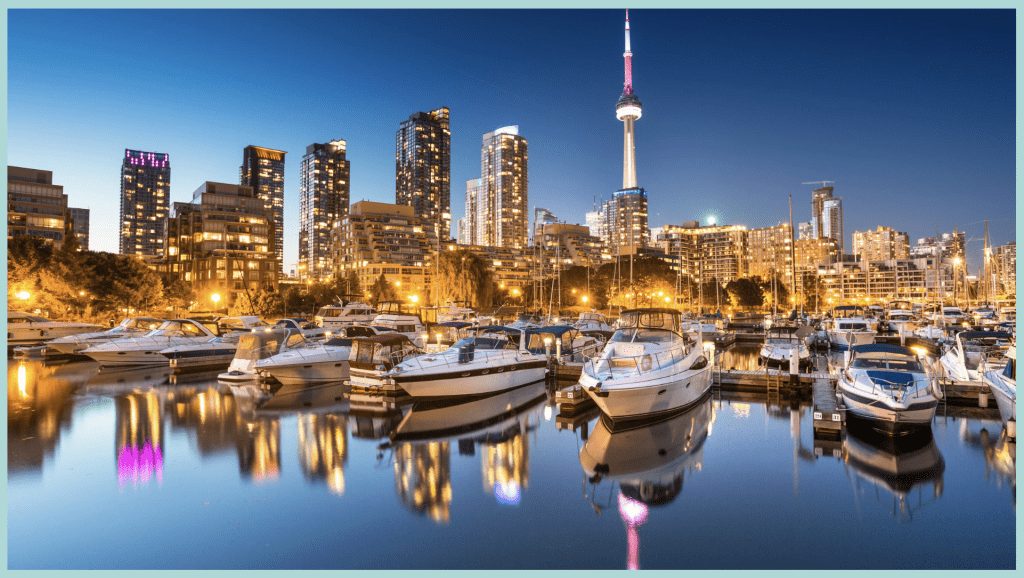
The employment market in Canada is robust and varied, with major sectors including technology, finance, healthcare, and natural resources. The country has low unemployment rates and provides various opportunities for skilled workers through immigration programs.
Canada’s education system is globally respected, offering free public schooling up to secondary level and relatively affordable higher education at prestigious institutions like the University of Toronto, McGill University, and the University of British Columbia.
In a parliamentary democracy, Canada operates as a constitutional monarchy, with the prime minister acting as the head of state. It is recognized for its stable political framework and effective governance.
Cost of Living in canada
The price of living in Canada varies by area, although on average
- Healthcare Expenses: CAD 60 to CAD 300 per month
- Transportation Costs: CAD 100-125 per month
- Groceries: CAD 1,200 to CAD 1,500 per month for a family
- Cost of Living Index: Around 62-66
- Average Rent: CAD 2,000-2,500 per month
Traveling Expense Guide to Canada
If you plan to visit Canada, it is important to budget accordingly.
- Visa Costs:
- Visitor visa (including super visa): CAD 100
- Traveling Costs:
- Average daily cost per person: CAD 270
- Accommodation Costs:
- 1-bedroom apartment (city center): CAD 1,850
- 1-bedroom apartment (outside center): CAD 1,650
- 3-bedroom apartment (city center): CAD 2,950
- 3-bedroom apartment (outside center): CAD 2,550
Canada is a top choice for living, working, and traveling, offering stunning landscapes, a thriving economy, and a welcoming environment. While the cost of living can be high, the country’s excellent public services and quality of life make it a desirable place to reside.
13. New Zealand
New Zealand, a gorgeous island nation in the Pacific Ocean, is famous for its amazing scenery, culture of Maoris, and high standard of living. Its overall area is 268,021 square kilometers, and its population is around 5.2 million. Some of its most famous attractions include Milford Sound, Queenstown, Mount Cook, Rotorua, Hobbiton, the Bay of Islands, and the Tongariro Alpine Crossing. The country is a paradise for outdoor lovers, offering activities such as hiking, skiing, and bungee jumping. The inflation rate in New Zealand typically ranges between 4-6%, influenced by housing prices, fuel costs, and global economic trends.
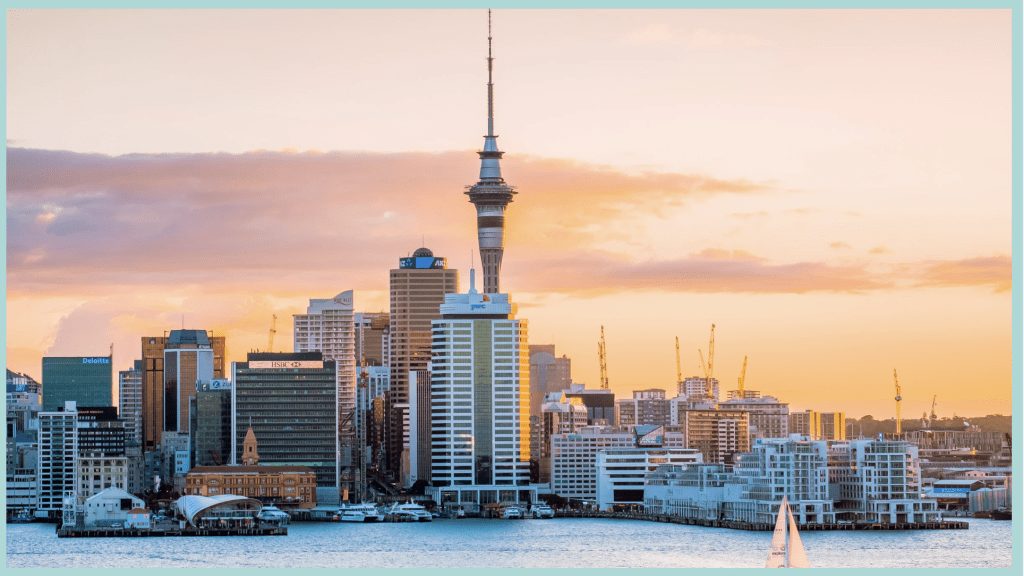
New Zealand has a robust work market, with opportunities in agriculture, healthcare, information technology, tourism, and construction. The unemployment rate remains low, and the government encourages skilled migration to fill labor shortages. The education system is among the greatest in the world, with people receiving free basic and secondary education and hosting prestigious universities such as the University of Auckland and the University of Otago.
The standard of living in New Zealand is high, with clean cities, beautiful landscapes, and a low crime rate. The healthcare system is well-developed, providing publicly funded healthcare to residents, though private health insurance is available, costing NZD 60-150 per month per person.
- Cost of Living in New Zealand
- Healthcare Expenses: NZD 60-150 per month for private insurance
- Transportation Costs: NZD 150-215 per month
- Cost of Groceries: NZD 600-700 per month for two people
- Cost of Living Index: Approximately 63-67
- Average Rent: NZD 1,200-2,500 per month
Traveling Expense Guide:
New Zealand is a favorite among tourists, although the cost varies according to travel style.
- Visa Costs:
Online application: NZD 170-245
Paper application: NZD 230-390 - Traveling Costs:
Average daily travel cost per person: NZD 317 - Accommodation Costs:
1-bedroom apartment (city center): NZD 1,825
1-bedroom apartment (outside center): NZD 1,535
3-bedroom apartment (city center): NZD 2,910
3-bedroom apartment (outside center): NZD 2,500
With its excellent healthcare, stunning natural environment, and high level of living, New Zealand is a popular destination for both locals and tourists. The quality of life, safety, and economic opportunities make it a desirable place to live, work, and explore, even with the relatively high cost of living.
14. Ireland
Ireland, a gorgeous island nation in Northwestern Europe, is known for its breathtaking scenery, rich history, and vibrant cultural scene. Its territory is 70,273 square kilometers, and its population is around 5.3 million. Some of its most well-known sights are the Cliffs of Moher, the Ring of Kerry, the Giant’s Causeway, Dublin’s Temple Bar, Blarney Castle, and the Wild Atlantic Way. The inflation rate in Ireland fluctuates between 4-6%, mainly driven by housing, energy costs, and economic factors.
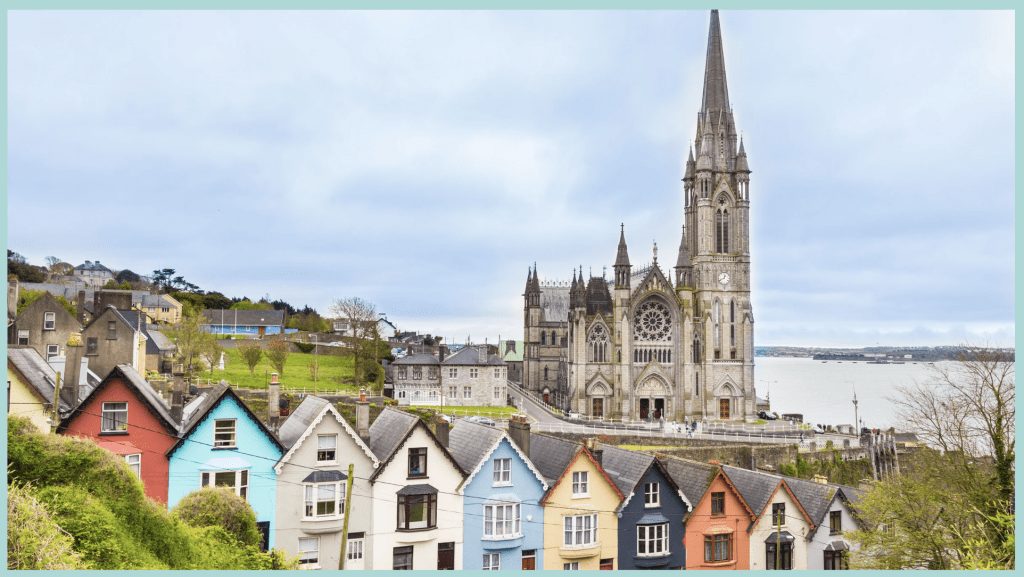
Ireland boasts a strong and diverse employment sector, with major industries in technology, pharmaceuticals, finance, healthcare, and tourism. As a European technology hub, it houses the headquarters of worldwide corporations such as Google, Facebook, and Apple. The educational system is highly regarded, with free primary and secondary education and prominent colleges including Trinity College Dublin and University College Dublin.
Ireland has a high level of living, including good healthcare, robust social services, and a growing economy. The healthcare system is a mix of public and private services, with free GP visits for eligible residents, while others pay between €40-100 per visit. The government follows a parliamentary democracy, where the Taoiseach (Prime Minister) heads the administration, while the President serves as the ceremonial leader.
Cost of Living in Ireland
- Healthcare Expenses: Free for GP visit card holders; others pay €40-100 per visit
- Transportation Costs: €120-150 per month
- Cost of Groceries: €300-400 per month
- Cost of Living Index: Approximately 63-66
- Average Rent: €1,400 per month
Traveling Expense Guide
Ireland is a popular travel destination, but costs vary depending on your budget.
- Visa Costs:
- Single-entry visa: €60
- Multiple-entry visa: €100
- Traveling Costs:
- Average daily travel cost per person: €169
- Accommodation Costs:
- 1-bedroom apartment (city center): €1,600
- 1-bedroom apartment (outside center): €1,385
- 3-bedroom apartment (city center): €2,690
- 3-bedroom apartment (outside center): €2,220
Ireland is an economically strong and culturally vibrant country, offering a high quality of life, diverse job opportunities, and world-class education. While the cost of living is relatively high, its excellent infrastructure, beautiful landscapes, and welcoming communities make it a desirable place for both residents and travelers.
15. Sweden
Sweden, a Scandinavian country famed for its beautiful natural landscapes, rich history, and high standard of living, is one of the most developed in the world. With a population of more than 10.5 million and an area of 450,295 square kilometers, it is one of the largest countries in Europe.. Some of Sweden’s most famous places include Stockholm’s Gamla Stan (Old Town), the Icehotel in Jukkasjärvi, the Northern Lights in Abisko National Park, the Vasa Museum, Drottningholm Palace, and the Stockholm Archipelago. The inflation rate in Sweden varies between 4-8%, influenced by housing, energy prices, and economic trends.
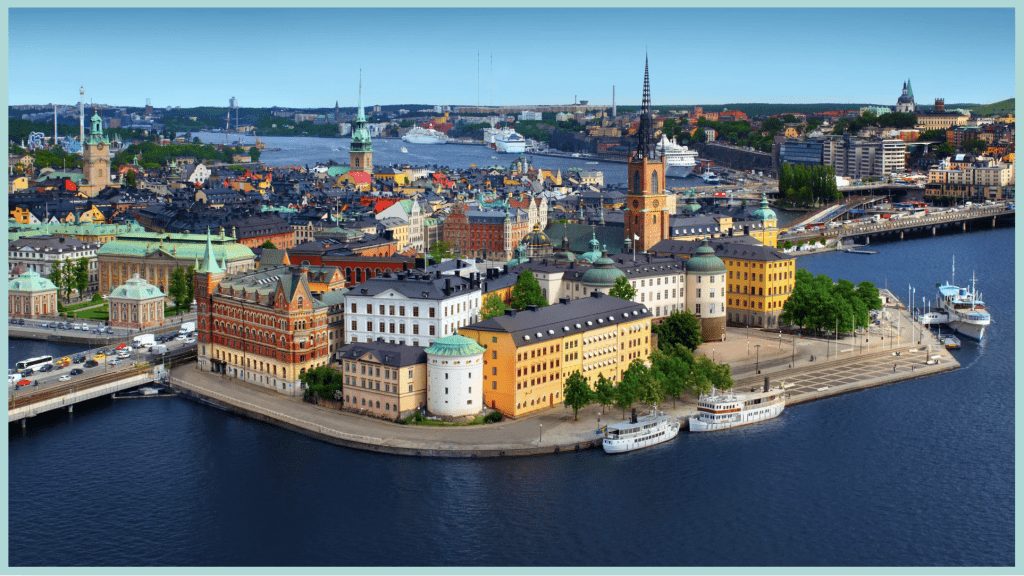
Sweden has a strong and diverse job market, with major industries in technology, automotive, pharmaceuticals, finance, and renewable energy. Companies like Volvo, IKEA, Ericsson, and Spotify contribute significantly to the economy. The education system is among the best in the world, with free primary and secondary education and renowned universities like Lund University, Uppsala University, and the Karolinska Institute. Higher education is tuition-free for EU/EEA citizens, whereas foreign students pay the tuition fees.
Sweden has a high standard of living and is ranked among the top nations for social welfare, work-life balance, and quality of life.. The government subsidizes the healthcare system, which makes public healthcare affordable. Private health insurance can range from SEK 300 to 700 per month, while public healthcare is heavily subsidized for residents.
Sweden is a monarchical system with parliamentary democracy.The Riksdag (Swedish Parliament) consists of 349 members who make legislative decisions. Sweden is known for its transparent governance, strong welfare policies, and progressive social system.
Cost of Living in Sweden
- Healthcare cost: Public healthcare is government-subsidized, while private insurance typically ranges from SEK 300 to 700 per month.
- Transportation Costs: SEK 800-1,200 per month
- Cost of Groceries: SEK 3,000-5,000 per month
- Cost of Living Index: Around 110-120
- Average Rent: SEK 8,000-12,000 per month
Traveling Expense Guide
Sweden is a beautiful travel destination, but visitors should be financially prepared.
- Visa Costs:
- Short-stay visa: €90
- Long-stay visa: €60
- Children (6-11 years old): €45
- National long-stay visa: €145
- Traveling Costs:
- Average daily travel cost per person: SEK 1,725
- Accommodation Costs:
- 1-bedroom apartment (city center): SEK 9,333
- 1-bedroom apartment (outside center): SEK 7,095
- 3-bedroom apartment (city center): SEK 15,138
- 3-bedroom apartment (outside center): SEK 11,535
Sweden is also known for its strong environmental policies, innovative technology sector, and commitment to sustainability. Sweden remains one of the most desired destinations to live, work, and visit, because of its progressive social policies, outstanding infrastructure, and picturesque landscapes.
16. The Netherlands
The Netherlands, noted for its beautiful canals, windmills, and tulip fields, is one of Europe’s most developed and densely populated countries. It has about 17.8 million inhabitants and encompasses 41,543 square kilometers. The Netherlands is well-known for its canals, Rijksmuseum, Van Gogh Museum, Anne Frank House, Keukenhof Gardens, Kinderdijk windmills, and the dynamic metropolis of Rotterdam. The inflation rate in the Netherlands fluctuates between 3-7%, primarily affected by energy prices, housing, and consumer goods.
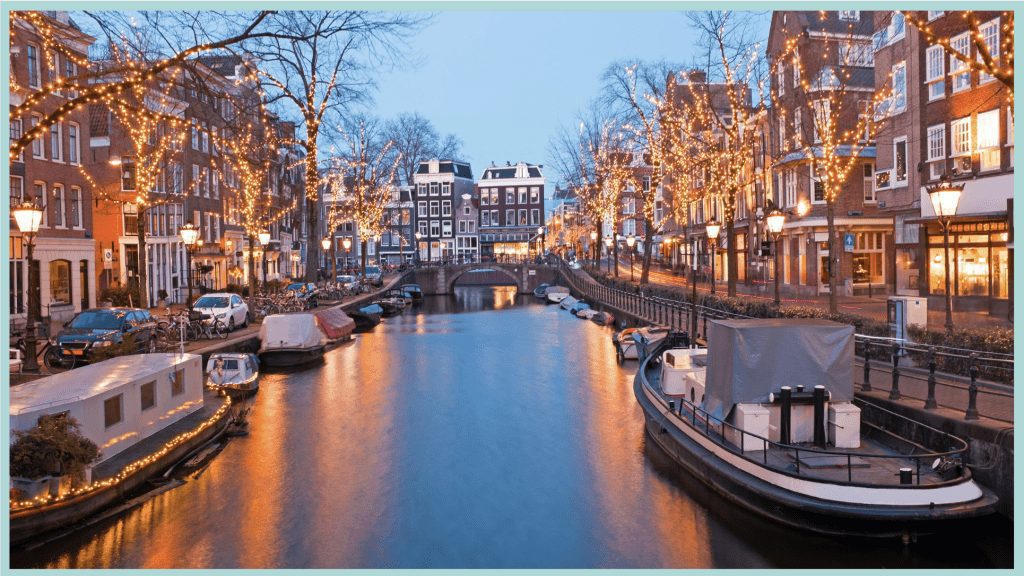
The Netherlands has a strong and diverse job market, with leading industries in technology, finance, logistics, agriculture, and renewable energy. Many global companies, including Philips, Heineken, Shell, and ING, are headquartered here. The education system is highly ranked, with free primary and secondary education, and world-class universities such as the University of Amsterdam, Leiden University, and Delft University of Technology. Higher education is affordable for EU students, while international students pay tuition fees based on their program.
The Netherlands has a high level of life, with good infrastructure, an economic boom, and advanced social policies. The healthcare system is one of the best in the world, with public healthcare well-covered and private insurance costs ranging from EUR 100 to EUR 200 per month. Dutch citizens and residents must have basic health insurance, which covers the majority of medical treatments.
The Netherlands is a monarchical system with parliamentary democracy. King Willem-Alexander serves as the ceremonial head of state, and the prime minister is in charge of the government. The Dutch Parliament, also known as the Staten-Generaal, is divided into two houses that make legislative decisions. The country is recognized for its stable administration, strong rule of law, and progressive social programs.
Cost of Living in the Netherlands
- Healthcare Cost: Public healthcare is fully covered, whereas private insurance costs EUR 100-200 per month.
- Transportation Costs: EUR 50-100 per month
- Cost of Groceries: EUR 300-500 per month
- Cost of Living Index: Around 61-66
- Average Rent: EUR 1,200-2,000 per month
Traveling Expense Guide
The Netherlands is a popular tourist destination, but travelers should budget accordingly.
- Visa Costs:
- Schengen Visa for adults: €90
- Children (6-12 years old): €45
- Below 6 years old: Application fee is Free
- Traveling Costs:
- Average daily travel cost per person: €205
- Accommodation Costs:
- 1-bedroom apartment (city center): €1,400
- 1-bedroom apartment (outside center): €1,115
- 3-bedroom apartment (city center): €2,210
- 3-bedroom apartment (outside center): €1,760
Another well-known aspect of the Netherlands is its bicycle culture., creative urban design, and strong environmental legislation. With its rich history, cultural attractions, and economic opportunities, the country is one of the most desirable places to live, work, and visit.
17. Finland
Finland, known for its breathtaking landscapes, Northern Lights, and world-class education system, is a Nordic country in Northern Europe.It is home to almost 5.6 million people and covers 338,455 square kilometers. Some of the most famous places in Finland include Helsinki (the capital city), Lapland (a prime location for viewing the Northern Lights), Suomenlinna Fortress, Santa Claus Village, the Finnish Archipelago, and Lake Saimaa. The inflation rate in Finland varies between 3-6%, influenced by energy prices, food costs, and housing.
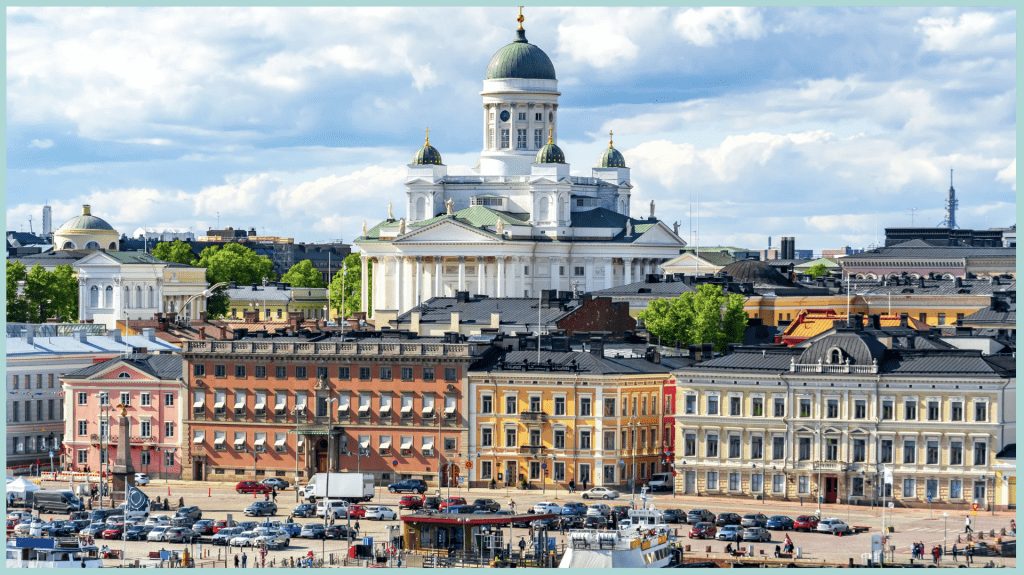
Finland has a strong job market in technology, telecommunications, forestry, and renewable energy, with companies like Nokia and KONE. It offers high wages, good work-life balance, and low unemployment. Education is free for EU students, with minimal fees for non-EU students.
Finland has a good level of living, little crime, and an environment that is clean. Public healthcare is affordable or free, while private insurance costs EUR 100-200 per month.
Cost of Living in Finland
- Healthcare Expenses:Public healthcare is widely accessible, while private insurance typically costs between EUR 100-200 per month
- Transportation Costs: EUR 50-100 per month
- Cost of Groceries: EUR 300-500 per month
- Cost of Living Index: Approximately 60-65
- Average Rent: EUR 900-1,500 per month
Traveling Expense Guide
Finland is a beautiful travel destination, but visitors should plan their expenses wisely.
- Visa Costs:
- Short-stay visa: €80
- National visa: €75
- For children aged 6 to 11, the cost is €40,
- Age under 6 years can access services for free.
- Traveling Costs:
- Average daily travel cost per person: €181
- Accommodation Costs:
- 1-bedroom apartment (city center): €783
- 1-bedroom apartment (outside center): €635
- 3-bedroom apartment (city center): €1,350
- 3-bedroom apartment (outside center): €1,020
Additional Information
Finland is also famous for its saunas, innovative technology, and high levels of happiness and well-being. With its stunning nature, strong economy, and excellent public services, Finland is one of the best countries to live, work, and visit.
18. France
France, located in Western Europe, is recognized for its rich history, notable landmarks, and wonderful cuisine. Over 68 million people live in the country, which has a total area of 551,695 km². Famous attractions in the nation include the Louvre Museum, Palace of Versailles, Disneyland Paris, Mont Saint-Michel, the Eiffel Tower, and the French Riviera (Côte d’Azur).. With a diverse landscape that includes bustling cities, picturesque villages, vineyards, and alpine regions, France remains one of the most visited countries in the world.

The French economy is among the largest globally, driven by luxury goods, aerospace, automotive, tourism, and technology. While inflation fluctuates, it remains within the EU standards. The employment market is stable, offering strong labor protections and a well-developed welfare system.
France’s education system is highly regarded, with free public schooling and affordable university tuition for both domestic and EU students. The country also has famous universities like Sorbonne University.
The standard of living in France is high, offering a mix of modern infrastructure, efficient public transport, and a rich cultural lifestyle. The healthcare system is ranked among the best in the world, with public healthcare covering most medical expenses, while private insurance costs between EUR 100 and EUR 200 per month.
The country boasts a robust democratic structure, with a National Assembly and a Senate.
Cost of Living in France
- Healthcare Expenses: EUR 100-200 per month for private insurance
- Transportation Costs: EUR 50-80 per month
- Groceries: EUR 300-500 per month
- Cost of Living Index: Around 61-66
- Average Rent: EUR 800-1,500 per month
Traveling Expense Guide
If you’re planning a trip to France, consider these financial aspects:
Visa Costs:
- Schengen Visa & Airport Transit Visa: EUR 90
- Children (6-12 years): EUR 45
- Under 6 years: Free
Traveling Costs:
- Average daily expense: EUR 262 per person, including accommodation, food, and transport
Accommodation Costs:
- 1-bedroom apartment (city center): EUR 770
- 1-bedroom apartment (outside center): EUR 600
- 3-bedroom apartment (city center): EUR 1,442
- 3-bedroom apartment (outside center): EUR 1,127
France is an international leader in tradition, style, and creativity, with a high standard of living, good healthcare, and numerous job options. While the cost of living can be high, the country’s vibrant cities, historical landmarks, and scenic countryside make it an attractive destination for residents and visitors alike.
19. The United States of America
North America’s largest and most varied nation, the United States of America (USA), is renowned for its technological achievements, cultural sway, and economic might. It is the world’s third-largest country, spanning 9.8 million km² and home to around 332 million people. The USA boasts iconic landmarks like the Grand Canyon, Statue of Liberty, Yellowstone National Park, Hollywood, Times Square, and the White House. Major cities such as New York, Los Angeles, Chicago, and Washington, D.C. draw millions of tourists annually.

The U.S. economy is the largest in the world, driven by technology, finance, healthcare, entertainment, and manufacturing. The inflation rate fluctuates but has remained a key focus of economic policy. The employment rate is strong, with diverse opportunities across industries, but wages and job security vary by sector and location.
The education system in the USA is among the most prestigious globally, with top universities like Harvard, MIT, and Stanford. Public education is free for K-12, but higher education is costly, with tuition fees ranging from $10,000 to $50,000 per year.
The standard of living is high, offering modern infrastructure, a strong economy, and a diverse cultural environment. However, living costs vary significantly between cities and states. The healthcare system is privatized, and while it offers advanced medical services, it is expensive. Private health insurance costs between $100 and $500 per month, based on the policy.
Cost of Living in the USA
- Healthcare Expenses: USD 100-500 per month for private insurance
- Transportation Costs: USD 70-150 per month
- Groceries: USD 300-500 per month
- Cost of Living Index: Approximately 78-84
- Average Rent: USD 1,000-3,000 per month
Traveling Expense Guide
If you’re planning a trip to the USA, consider these costs:
Visa Costs:
- Visitor Visa (B1/B2): USD 185
Traveling Costs:
- Average daily expense: USD 404 per person, including accommodation, food, and transport
Accommodation Costs:
- 1-bedroom apartment (city center): USD 1,740
- 1-bedroom apartment (outside center): USD 1,437
- 3-bedroom apartment (city center): USD 2,900
- 3-bedroom apartment (outside center): USD 2,394
The USA is a global powerhouse, offering high economic opportunities, world-class education, and diverse cultural experiences. However, healthcare and living costs can be high, making financial planning essential for both residents and travelers.
20. Japan
Japan, an East Asian island nation, is well-known for its rich cultural legacy, cutting-edge technology, and magnificent scenery. Japan encompasses 377,975 km² and has a population of almost 125 million individuals. It is famous for its iconic landmarks such as Mount Fuji, Tokyo Tower, Kyoto’s temples, Osaka Castle, and Hiroshima Peace Memorial Park. The country blends ancient traditions with modern advancements, making it one of the most unique travel destinations in the world.

Japan has a strong and stable economy, driven by industries like automobiles, electronics, robotics, and finance. The inflation rate has been relatively low compared to other major economies. The employment rate is high, with a culture that values hard work and dedication. However, long working hours and job security concerns remain significant issues.
The education system in Japan is among the best in the world, emphasizing discipline, academic excellence, and innovation. Public schools provide a high-quality education, while prominent colleges such as the University of Tokyo and Kyoto University draw students from all over the world.
The standard of living is high, with efficient public transport, low crime rates, and a high-quality urban lifestyle. Japan’s healthcare system is one of the most efficient, offering universal coverage through public insurance, while private insurance costs between JPY 10,000 to 20,000 per month.
Cost of Living in Japan
- Healthcare Expenses: JPY 10,000-20,000 per month for private insurance
- Transportation Costs: JPY 10,000-15,000 per month
- Groceries: JPY 30,000-50,000 per month
- Cost of Living Index: Around 90-100
- Average Rent: JPY 80,000-150,000 per month
Traveling Expense Guide
If you’re planning a trip to Japan, consider these expenses:
Visa Costs:
- Single-entry visa: JPY 3,000
- Double-entry visa: JPY 6,000
- Transit visa: JPY 700
Traveling Costs:
- Average daily expense: JPY 21,702 per person, covering accommodation, food, and transport
Accommodation Costs:
- 1-bedroom apartment (city center): JPY 86,950
- 1-bedroom apartment (outside center): JPY 59,730
- 3-bedroom apartment (city center): JPY 194,313
- 3-bedroom apartment (outside center): JPY 116,442
Japan is a technologically advanced nation with deep-rooted traditions, offering a high quality of life, excellent healthcare, and a thriving job market. However, living costs, long working hours, and cultural adaptation can be challenges for newcomers and travelers.
Tips for Traveling to Expensive Countries
If you plan to visit any of these expensive destinations, here are some tips to manage your budget:
- Book Flights Early: Airline tickets can be expensive, so book in advance to save money.
- Choose inexpensive Accommodations: Instead of luxurious hotels, think about staying in inexpensive hotels, hostels, or rental homes.
- Use Public Transport: Taxis and rental cars can be costly; public transport is a more affordable alternative.
- Save On Meal: Search for local street food or prepare your own dishes instead of dining at pricey restaurants.
- Plan Activities in Advance: Research free or low-cost attractions to enjoy without overspending.
Importance of Tourism in National Development
Tourism is a key driver of economic growth, job creation, and infrastructure development, benefiting both local communities and national economies.
- Economic Growth – Tourism boosts GDP through spending on hotels, transport, and attractions.
- Employment Opportunities – It creates millions of jobs in hospitality, transport, and services.
- Infrastructure Improvement – Authorities allocate funding to upgrade highways, airports, and public facilities.
- Cultural Exchange – Encourages global interaction and appreciation of different traditions.
- Cultural and environmental conservation ensures the preservation of natural environments and historic places.
- Sustainability – Promotes eco-tourism and responsible travel for environmental protection.
- Economic Diversification – Reduces reliance on other industries, ensuring stability.
- Boosts Local Businesses – Supports entrepreneurship in tourism-related services.
Tourism fosters economic resilience, cultural unity, and sustainable development, making it essential for a country’s progress.
Conclusion
Traveling to expensive countries can be a rewarding experience, offering access to stunning landscapes, rich cultures, and high-quality services. However, these places frequently have a high cost of living, necessitating cautious budgeting. Understanding expenses such as housing, transportation, food, and healthcare can help travelers make informed decisions and budget effectively. While countries like Switzerland, Norway, and the Bahamas offer luxurious lifestyles, they also demand higher financial commitments. By adopting smart travel strategies—such as booking flights early, choosing budget-friendly accommodations, and utilizing public transportation—you can enjoy these destinations without overspending. Ultimately, with the right planning, exploring the world’s most expensive countries can be both exciting and financially manageable.
FAQs
Why is Switzerland among the most costly countries?
Switzerland is pricey because of its high wages, robust economy, and superb infrastructure. The cost of living, which includes rent, healthcare, and food, is much greater than in other nations.
What factors contribute to a country being expensive?
Key factors include high living costs, strong currency, high taxes, import duties, a luxury lifestyle, and economic stability. Countries with expensive housing, healthcare, and daily expenses tend to have higher costs of living.
Is it possible to travel to expensive countries on a budget?
Yes, tourists may save money by booking flights early, staying at low-cost hotels, utilizing public transit, dining at local restaurants, and visiting free attractions.
Why is Norway regarded as costly?
Norway boasts high wages, great public services, and a thriving economy. Groceries, rent, and eating out are expensive due to hefty import tariffs and a strong Norwegian krone.
What are the living expenses like in Iceland?
Iceland has high rent, expensive imported goods, and costly transportation. The country's distant location and reliance on imports contribute to one of the highest cost of living indexes in Europe.
Which country has the highest cost of rent?
Switzerland, Hong Kong, and Singapore have some of the highest rental costs, especially in major cities like Zurich, Geneva, Hong Kong, and Singapore.
How does pricing affect the prices of living in these countries?
Inflation raises the cost of products and services, making basic necessities like food, transportation, and shelter more expensive. Countries with robust economy may have lower inflation rates, but costs are still significant.
Why are islands like the Bahamas and Iceland so expensive?
Island nations rely heavily on imports for food, fuel, and consumer goods, which raises prices. Additionally, tourism-driven economies often lead to higher living costs.
Is healthcare expensive in these high-cost countries?
Yes, healthcare in countries like the U.S., Switzerland, and Norway can be costly. However, many of these nations offer high-quality medical services with universal healthcare or mandatory insurance plans.

